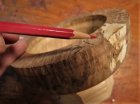Odie
Panning for Montana gold, with Betsy, the mule!
This is Yellow Box Burl. The almost white growth is on one side, and goes completely through from one side to the other. What is that? 
I'm tempted to say it's some kind of fungus, but there is a faint grain pattern within the white area that matches the surrounding wood......so, it appears to be some kind of discoloration of the wood itself. Very unusual......don't recall of ever seeing anything like this before.....
-----odie-----

I'm tempted to say it's some kind of fungus, but there is a faint grain pattern within the white area that matches the surrounding wood......so, it appears to be some kind of discoloration of the wood itself. Very unusual......don't recall of ever seeing anything like this before.....
-----odie-----



